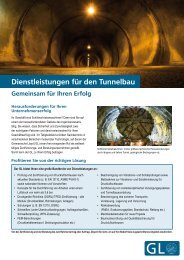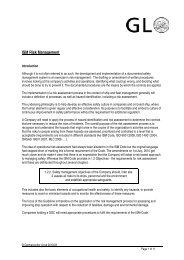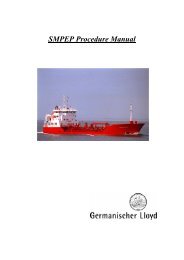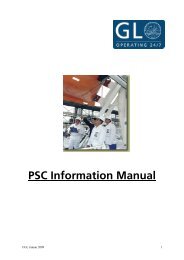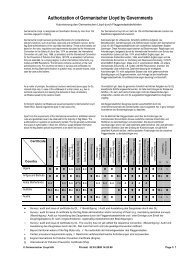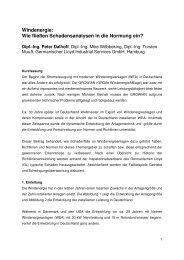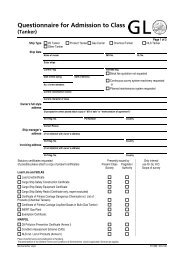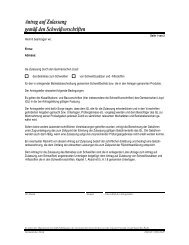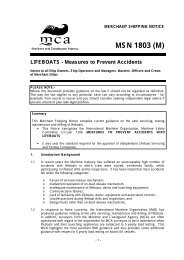Commercial Gas Management Solutions - GL Group
Commercial Gas Management Solutions - GL Group
Commercial Gas Management Solutions - GL Group
Create successful ePaper yourself
Turn your PDF publications into a flip-book with our unique Google optimized e-Paper software.
Energy <strong>Solutions</strong><br />
<strong>Commercial</strong> <strong>Gas</strong> <strong>Management</strong> <strong>Solutions</strong><br />
Germanischer Lloyd – Service/Product Description
<strong>Commercial</strong> <strong>Gas</strong> <strong>Management</strong><br />
<strong>Solutions</strong><br />
2<br />
Germanischer Lloyd – Service/Product Description<br />
Service Title: Energy <strong>Solutions</strong><br />
Lead Practice: <strong>GL</strong> - Energy <strong>Solutions</strong><br />
Page 3<br />
Pages 4 - 12<br />
a:<br />
b:<br />
c:<br />
d:<br />
Pages 13 - 15<br />
a:<br />
b:<br />
c:<br />
Contents<br />
Service Description and Values Generated<br />
Detailed Method Statement<br />
The detailed method statements explain how the<br />
work is conducted, which inputs are required and<br />
which outputs and results can be expected.<br />
System Requirements Study (SRS)<br />
Third Party Access <strong>Solutions</strong> for Underground <strong>Gas</strong><br />
Storage Operators and LNG Facilities<br />
Forecaster Implementation Services<br />
Application Support & Hosting Services<br />
Case Studies and Examples<br />
Access Manager for Star Energy (Underground <strong>Gas</strong><br />
Storage)<br />
Access Manager Implementation for Grain LNG<br />
E.ON Földgáz Trade (EFT) - Imbalance Penalty<br />
Reduction Through Accurate Demand Forecasting
Service Description<br />
and Values Generated:<br />
Liberalisation of energy markets around the world is having a<br />
profound impact upon the way in which energy suppliers and utilities<br />
operate. Historically it was not uncommon for a single company, often<br />
state owned, to own and operate the entire gas chain from well to<br />
meter. The introduction of competition is increasing the number of<br />
market players and more often than not, results in the unbundling of<br />
production, transmission, distribution, storage and supply. Operating<br />
in this new competitive environment requires fundamental changes to<br />
business processes and the software solutions that support them.<br />
Germanischer Lloyd (<strong>GL</strong>) is a world leading provider of commercial<br />
gas management and Third Party Access solutions and services:<br />
� System Requirement Studies<br />
An essential first step for any company looking to procure<br />
(or develop) a software solution is to clearly and<br />
unambiguously define their requirements. <strong>GL</strong> have a team<br />
of experienced consultants and a proven methodology<br />
for developing systems requirements specifications that<br />
can be used as the basis for an Invitation To Tender (ITT).<br />
� Third Party Access and Hydrocarbon Allocation<br />
<strong>Solutions</strong> for Underground <strong>Gas</strong> Storage Operators<br />
and LNG Facilities<br />
Access Manager provides a suite of configurable software<br />
modules to support the commercial operation,<br />
hydrocarbon allocation and Third Party Access for<br />
Underground <strong>Gas</strong> Storage Operators and LNG facilities.<br />
� <strong>Gas</strong> Demand Forecasting for Transmission and<br />
Distribution System Operators, and Energy<br />
Suppliers/Retailers<br />
Forecaster is an advanced forecasting solution that<br />
delivers future short term daily and hourly energy<br />
demands that are essential to gas transmission and<br />
distribution system operators and energy suppliers.<br />
Forecaster gives you manageable forecasts that maximize<br />
accuracy while minimizing effort.<br />
SERVICE DESCRIPTION<br />
� Application Support and Hosting Service<br />
<strong>GL</strong> provide a comprehensive application support and<br />
hosting operation, ready to meet the specific operational<br />
requirements of our customers in the energy industry. A<br />
24/7 application support operation ensures that our<br />
customers have access around the clock to our team of<br />
expert software engineers & consultants, ensuring that<br />
their business critical operations can continue to operate<br />
no matter the situation.<br />
3
DETAILED METHOD STATEMENT<br />
a. System Requirements Study (SRS)<br />
An essential first step before procuring (or developing) any software<br />
system is to clearly and unambiguously define the system<br />
requirements in a System Requirements Specification (SRS). This<br />
document can then be used as a basis for an Invitation To Tender (ITT)<br />
and/or used to evaluate the suitability of alternate solutions.<br />
The System Requirements Specification would typically include the<br />
following sections:<br />
4<br />
1) Problem Definition/Business Drivers<br />
This section will clearly define the business drivers and<br />
purpose for implementing the system. It will establish a<br />
common vision for the system and ensure that the<br />
requirements are business driven.<br />
2) Stakeholders<br />
This section will identify the users of the system and any<br />
parties (internal or external) that could be materially<br />
affected by its implementation.<br />
3) System Boundary<br />
The system boundary will define the border between the<br />
new system and any existing corporate systems. All data<br />
inputs and outputs will be defined.<br />
4) Functional Requirements<br />
This will describe the functional requirements of the<br />
system - how the system must behave - and will<br />
constitute the bulk of the report. It will be organized by<br />
module (for example nominations, contracts or<br />
allocations). Each of the features or behaviours will be<br />
classified as mandatory, desirable or “nice to have”. This<br />
last step is important for two reasons: firstly, it enables<br />
the requirements to be weighted when evaluating the<br />
suitability of off the shelf solutions, and secondly, it<br />
enables resources to be focused on essential features.<br />
For example, the functional requirements for a third party<br />
access system will typically cover the following functional<br />
areas:<br />
- Nominations<br />
- Allocations<br />
- Inventory<br />
- Contracts<br />
- Availability (including Site Operations Interface,<br />
Outages and Operations Support)<br />
5) Non-functional Requirements<br />
This section will identify the non-functional requirements<br />
for a system, such as:<br />
- Hardware (Client and Server)<br />
- Network infrastructure<br />
- Backup and Recovery<br />
- User Interface<br />
- Reliability<br />
- Availability<br />
- Performance<br />
- Support<br />
6) Design Constraints<br />
This section will identify restrictions on the design of the<br />
system, or the methodology by which it will be developed<br />
or implemented. Likely issues for consideration will be<br />
the existing IT infrastructure and ongoing support<br />
considerations.
Implementation<br />
<strong>GL</strong> use a tried and tested four-phase approach to conducting System<br />
Requirements studies:<br />
DETAILED METHOD STATEMENT<br />
Phase 1 - Data Gathering<br />
Our consultants carry out a number of structured workshops (typically<br />
over a period of two weeks) with representatives from the customer’s<br />
business to capture the system requirements. Feedback sessions are<br />
incorporated throughout the schedule to ensure that the consultants<br />
have correctly captured and understood the requirements before<br />
drafting the System Requirements Specification (SRS).<br />
Phase 2 - Compile System Requirements Specification.<br />
It typically takes two to three weeks for the consultants to complete<br />
their analysis of the information gathered in the workshops and<br />
produce the first draft of the SRS (Ver 0.1) for the customer to review.<br />
Phase 3 – Review Draft<br />
Two to three weeks is typically sufficient time for the customer to carry<br />
out a review of the draft SRS (Ver 01.) and for the Consultants to<br />
incorporate comments and issue SRS Ver 0.2.<br />
Phase 4 – Final Review<br />
One to two weeks is then required for a further review cycle before<br />
the final version, SRS Ver 1.0 is issued for sign-off by the customer.<br />
5
DETAILED METHOD STATEMENT<br />
b. Third Party Access and Hydrocarbon Allocation <strong>Solutions</strong><br />
for Underground <strong>Gas</strong> Storage Operators and LNG Facilities<br />
Access Manager is a Web-enabled system that provides a robust and<br />
reliable platform that meets the demands of today’s liberalised energy<br />
markets. Access Manager was developed specifically for the<br />
commercial environment of Third Party Access.<br />
Access Manager was first implemented in 2002 for the five LNG peak<br />
shaving sites in the UK. <strong>GL</strong> has continued investment and<br />
development in the system so that it has become a core solution. In<br />
Access Manager, we have the only proven end-to-end (ship to send<br />
out) terminal system in the UK.<br />
The experience of operating in the UK’s energy market has enabled <strong>GL</strong><br />
to develop a system that can be configured and customised to meet<br />
the constantly evolving market requirements. Access Manager is<br />
purposely designed to fit around the business, not the business<br />
around Access Manager.<br />
6<br />
Key Benefits of Access Manager:<br />
� Reduction in Operational Expenditure - Automation of<br />
key processes minimises manpower requirements. One<br />
customer was able to save in excess of £400k p.a. by<br />
configuring the system to electronically send alerts by<br />
phone removing the need for a 24/7 <strong>Commercial</strong><br />
Operations team<br />
� A proven solution that reduces risk and delivery timescales<br />
compared with a bespoke development<br />
� Facilitates the optimisation of operations through the<br />
provision of accurate and timely information to key<br />
stake-holders (including commercial and system operations,<br />
customers, shareholders etc.)<br />
� Highly flexible – Modules can be configured or tailored<br />
to meet specific customer requirements<br />
� Security and audit features ensure confidentiality of the<br />
user parties’ data and demonstrates regulatory<br />
compliance<br />
� Low cost of ownership achieved through flexible user<br />
configurability and support, for example simple changes<br />
(such as screen appearance) can be made by system<br />
administrators<br />
� Demonstrates regulatory compliance and supports<br />
Secondary Trading and UIOLI rules (Use It Or Lose It)<br />
� The modular nature of the system reduces the cost and<br />
risk of extending the system to other users and future<br />
project phases<br />
� Business process automation enables internal IT staff to<br />
maintain the system without detailed knowledge of<br />
stakeholder processes<br />
� Remote, secure web based access to the system<br />
� Multi language support enables the system to be<br />
deployed World wide
Implementation<br />
<strong>GL</strong> follows a tried and tested process for implementing its Access<br />
Manager solution:<br />
Project Phases:<br />
Stage 0 - Pre-project Planning<br />
The project begins with an internal kick-off meeting to mobilise the<br />
project team, assign roles and responsibilities, and discuss the overall<br />
project objectives. During this stage the <strong>GL</strong> project manager will<br />
develop the project plan including a detailed quality plan, for approval<br />
by the customer<br />
Stage 1 - Gap Analysis (Analysis & Design)<br />
During this phase <strong>GL</strong> will analyse the gap between the base Access<br />
Manager solution and the customer requirements. A solution will be<br />
designed and documented in the Functional Design Specification<br />
(FDS).<br />
Stage 2 - Configuration and Customisation<br />
This phase incorporates the key activities of making configuration and<br />
customisation changes to Access Manager in order to meet the<br />
Functional Design Specification.<br />
Stage 3 - FAT Testing<br />
<strong>GL</strong> carry out comprehensive factory acceptance testing at it’s premises<br />
which includes Unit, Module and end to end System Integration<br />
testing.<br />
Stage 4 - Deploy and SAT<br />
Following a successful Factory Acceptance Test the system is installed<br />
at the client’s site and Site Acceptance Testing is carried out.<br />
Stage 5 - Training<br />
End users and administrators are trained in how to use and<br />
administrate the system prior to carrying out User Acceptance Testing.<br />
Stage 6 - User Acceptance Testing<br />
The system is comprehensively tested by the customer to ensure that<br />
it delivers the functionality as defined in the Functional Design<br />
Specification.<br />
DETAILED METHOD STATEMENT<br />
Post Implementation Support and Services<br />
<strong>GL</strong> provides comprehensive 2nd line technical support for our clients.<br />
This includes call logging, tracking and management, through to<br />
problem diagnosis and problem resolution, including escalation<br />
management.<br />
A number of options with defined service levels are available ranging<br />
from working hours support through to 24/7 including application<br />
hosting.<br />
7
8<br />
DETAILED METHOD STATEMENT<br />
c. Forecaster Implementation Services<br />
Forecaster Overview<br />
<strong>Gas</strong> transmission and distribution companies, shippers and traders<br />
are all interested in forecasting gas demand. The extent of this<br />
depends largely on the type of market they are operating in. The key<br />
drivers behind gas forecasting will be a subset of the following:<br />
� The need to reduce imbalance penalties imposed by the<br />
regulator/transporter<br />
� The need to maintain security of supply<br />
� The need to manage gas storage efficiently<br />
� The need to book sufficient capacity in the future<br />
� The need to operate a gas network efficiently and safely<br />
� The need to optimise CAPEX by pinpointing capacity<br />
constraints<br />
� The need to make informed buying/selling decisions in<br />
times of price volatility<br />
The <strong>GL</strong> Forecaster product is aimed at addressing all these business<br />
drivers by providing the flexibility to operate within different parts of<br />
the industry. Forecaster can drive operations by providing accurate<br />
short term predictions (within the day and day ahead) at each<br />
metered demand point, or at any aggregation of points. Moreover,<br />
the granularity, frequency and forecast horizon are all configurable<br />
within the system. The product can also be configured to predict<br />
long term demand patterns, and is therefore a powerful tool to feed<br />
into planning activities.<br />
Built into the product are a number of algorithms that can be used to<br />
generate forecasts and the choice of algorithm depends on the nature<br />
of the problem being solved. Forecaster currently supports the<br />
following methodologies:<br />
� Neural networks<br />
� Multiple Linear Regression<br />
� Multiple Non-Linear Regression<br />
� ARIMA (Auto-Regressive Moving Average)<br />
� Adaptive Combination<br />
� Bayesian<br />
� Profiling and utility models<br />
Forecaster has built in capability to automate the key processes<br />
required to capture input data, train the models, generate forecasts<br />
and output the results.<br />
Forecaster - Key Benefits<br />
� The most important benefit is improved accuracy of<br />
demand forecasts as these feed into many other business<br />
processes. Some of our clients have achieved reductions<br />
in Mean Absolute Percentage Error by as much as 50%<br />
compared with existing forecasting methods with typical<br />
improvements of between 5-35%. This very much<br />
depends on client’s existing modelling methods, data<br />
quality, history and availability. For example one client<br />
reduced their average portfolio error from 15% to 7%,<br />
another from 5.5% to
Forecaster Implementation Service Overview<br />
<strong>GL</strong> has world-class gas demand forecasting expertise with specific<br />
knowledge of how forecasting models are configured within<br />
Forecaster.<br />
An extensive range of consultancy services are available to guide the<br />
customer through a successful Forecaster implementation. These<br />
include:<br />
� Detailed requirements capture to understand and<br />
document the clients needs<br />
� Initial Study – to demonstrate our forecasting capability<br />
and the level of accuracy that can be achieved using client<br />
data<br />
� Forecaster Trial – to set up a trial version of the product to<br />
allow the client to use for a defined period of time<br />
� Forecaster Implementation – client data analysis and<br />
model configuration through to installation, integration,<br />
training and testing<br />
� Continuous Improvement – application and configuration<br />
support through the <strong>GL</strong> dedicated support function.<br />
Ongoing modelling consultancy can also be provided to<br />
monitor forecasting accuracy and adapt models to<br />
changing market conditions.<br />
DETAILED METHOD STATEMENT<br />
Requirements Capture<br />
Once the client has established their business case for purchasing a<br />
forecasting solution, <strong>GL</strong> can provide consultancy support to elicit the<br />
detailed business and IT requirements of the customer in respect of<br />
the system. <strong>GL</strong> have a tried and tested methodology for capturing<br />
and documenting these requirements.<br />
Initial Study<br />
Business<br />
Case<br />
Using <strong>GL</strong> forecasting expertise, we suggest to the client a two to three<br />
week consulting study that analyses representative data for a few<br />
demand points, configures them into Forecaster, develops and assigns<br />
models, and reports on the likely accuracy that could be achieved<br />
highlighting any data issues.<br />
To support this activity, the client provides <strong>GL</strong> with input data for up<br />
to 10 demand points the client has historically forecast. The client<br />
may wish to provide a range of demand types representative of their<br />
portfolio to test our capability. Input data would typically include<br />
historical demand and other information considered to be a driver of<br />
the forecast, such as weather data.<br />
We will analyse the input data for each demand point, and depending<br />
on the demand pattern, data quality etc, configure and train the<br />
Forecaster models on an agreed test period and generate forecasts<br />
over the remaining period. The results of this study are presented to<br />
the client and compared with equivalent accuracy figures.<br />
The evaluation delivers a summary report providing an outline of<br />
accuracy, data issues and recommendations. Fees are based on<br />
estimated cost of services.<br />
9
10<br />
DETAILED METHOD STATEMENT<br />
Forecaster Trial<br />
Following on from an initial study where we have demonstrated the<br />
potential accuracy that Forecaster can achieve, the client may wish to<br />
trial the Forecaster product to test its robustness as an operational<br />
tool to ensure it meets their functional requirements and fits in with<br />
their IT infrastructure.<br />
Typically, as part of an evaluation or pilot, <strong>GL</strong> would set up a trial<br />
database with a small number of demand points configured to run<br />
operationally. The client may wish to create an automated data<br />
loading mechanism to feed the system using ‘as-live’ data, or they<br />
could set up a manual procedure to carry out the required activities<br />
each day.<br />
<strong>GL</strong> would help the client set up the database, install the system (with<br />
a temporary licence) and deliver an introductory training course<br />
enabling the client to make full use of the product during the<br />
evaluation period.<br />
The Forecaster trial will assist the client’s understanding of what can<br />
be achieved and helps refine their requirements so that we can<br />
provide a detailed proposal for subsequent implementation. This has<br />
the benefit of ensuring that the solution meets the client’s<br />
expectations.<br />
Implementation<br />
<strong>GL</strong> employs a tried and tested method for implementing Forecaster<br />
according to the following basic stages:<br />
1) Analysis and Specification<br />
Involves workshops with the client to understand how<br />
Forecaster needs to be configured, what data is available,<br />
what is to forecast etc. The output from this is a<br />
Configuration Specification which the client signs off.<br />
2) Initial Configuration<br />
Following approval of the Configuration Specification, we<br />
create a Forecaster database configured for the client.<br />
This includes forecast horizons, demand points, weather<br />
and other input variables.<br />
3) Data Migration<br />
Demand and other input data (e.g. temperature) is<br />
migrated into the Forecaster database either by the client<br />
or <strong>GL</strong>. This information is provided by the client. We can<br />
optionally carry out analysis of the data quality and clean<br />
up the data as necessary.<br />
4) Modelling (optional)<br />
As an optional phase, <strong>GL</strong> will carry out analysis of the<br />
migrated data and investigate the best type of model to<br />
apply to each demand point. If the client has already<br />
carried out this analysis, or if the client has specific models<br />
they wish to implement directly in Forecaster, these will be<br />
configured in the next stage.<br />
5) Model Configuration<br />
Based on models identified in stage 4, or models the<br />
client wishes to be implemented, <strong>GL</strong> will carry out the<br />
necessary model configuration and assign them to the<br />
demand points according to their classification. At this<br />
stage the Scheduler component is also set-up to<br />
automate all the key tasks.<br />
6) Factory Acceptance Testing<br />
The fully configured Forecaster system is thoroughly<br />
tested at our office to ensure it fully meets the needs of<br />
the client. This includes an element of operational<br />
testing, where Forecaster runs on ‘as-live’ information.<br />
7) Installation<br />
We carry out on-site installation of Forecaster and the<br />
database. At this stage, the client is guided through this<br />
process, with reference to the installation guide, to ensure<br />
this knowledge is transferred.<br />
8) Site Acceptance Testing<br />
Once Forecaster has been installed on-site, <strong>GL</strong> engineers<br />
run a sub-set of the critical Factory Acceptance Tests to<br />
ensure the system runs as expected in the target<br />
environment.<br />
9) Training<br />
Before the system is handed over to the client, we carry<br />
out an introductory and intermediate training course<br />
aimed at key users of the system and testers the client<br />
may be using. A System Administration course which<br />
covers installation, system architecture and<br />
troubleshooting for the Forecaster system is also<br />
provided.<br />
10) User Acceptance Testing Support<br />
Following successful SAT and client training, the system is<br />
handed over to the client for them to carry out their<br />
testing. Typically, the client will have pre-defined the tests<br />
they wish to carry out based on their user requirements.<br />
Following this phase, the client signs off the system as<br />
ready for go-live. <strong>GL</strong> would provide support as part of<br />
the implementation project during this period to address<br />
any issues that may arise.
Post Implementation Support and Services<br />
<strong>GL</strong> provides comprehensive technical support for Forecaster clients.<br />
This includes call logging, tracking and management, through to<br />
problem diagnosis and problem resolution, including escalation<br />
management.<br />
A number of options with defined service levels are available ranging<br />
from working hours support through to 24/7.<br />
In addition to application support, <strong>GL</strong> can provide additional<br />
consultancy to monitor the on-going accuracy of the client’s<br />
forecasting models and provide recommendations for potential<br />
improvements. This situation may be beneficial to the client if they do<br />
not have the resources in-house to carry out this activity themselves.<br />
Additional training can also be provided, including an Advanced<br />
Training course which covers model configuration and is aimed at<br />
users who have used the system for a while and would like to take the<br />
models to the next level.<br />
There are a wide range of forecasting methods available in Forecaster<br />
which covers most client needs. However, there may be some<br />
situations where the client would like to investigate new techniques<br />
such as neural fuzzy, support vector machines, Artificial Logic<br />
Networks etc. <strong>GL</strong> have a long history of carrying out research and<br />
development activities in the area of gas demand forecasting and<br />
have provided this level of service to clients in the past.<br />
DETAILED METHOD STATEMENT<br />
d. Application Support & Hosting Services<br />
<strong>GL</strong> recognises the importance of an effective application support and<br />
hosting service and the business benefits of a responsive, high quality<br />
service to support key business solutions in the energy industry. <strong>GL</strong><br />
has an excellent record for quality of service and have a commitment<br />
to provide a level of responsiveness driven by customer defined service<br />
levels.<br />
<strong>GL</strong> have been providing support services to the UK energy industry<br />
for over 20 years, ensuring that the systems operating the UK gas<br />
networks continue to function around the clock.<br />
Call handling software is used to log, record and monitor calls against<br />
customer specific service levels.<br />
Support Services<br />
� Location and Availability<br />
With <strong>GL</strong> offices around the world, 1st line support<br />
services can be established in locations closest to the<br />
customer, operating in their time zone and their<br />
language. Depending on the nature of the customer’s<br />
business and the business criticality of the operations, <strong>GL</strong><br />
can offer expert support coverage right through to 24<br />
hours a day, 7 days a week. This gives the customer<br />
access to expert software engineers and consultants, who<br />
can promptly resolve and get to the root cause of any<br />
application issue.<br />
� Call <strong>Management</strong><br />
Each call received by the helpdesk teams is recorded in a<br />
call logging system and given a call reference number.<br />
The caller is asked to provide the following information:<br />
- User identification and contact details<br />
- Description of the problem<br />
- Priority of call<br />
<strong>GL</strong> will acknowledge the acceptance of the call within the<br />
agreed SLA timings and contact the customer for further<br />
information, if required including:<br />
- Requests for screen shots<br />
- Error message texts<br />
- Confirmation of local IS problems (e.g. network or<br />
desktop failure; failed web access)<br />
- Information on actions taken to date<br />
- Information on steps required to reproduce the failure<br />
or circumstances under which failure occurred<br />
11
12<br />
DETAILED METHOD STATEMENT<br />
Initial problem diagnosis will be undertaken on the<br />
production system. In order to achieve the level of<br />
support required as effectively as possible, the Support<br />
Team often have controlled access to the production<br />
system so that the particular problem can be monitored<br />
and assessed.<br />
Further investigation, when necessary, takes place on<br />
internal development systems. Additional information<br />
and diagnostic data is often made available by the user on<br />
request to help with the resolution of the problem.<br />
In some cases, diagnosis may involve duplicating the<br />
problem to understand the issues. It may also be<br />
necessary to investigate the data and functionality of the<br />
system. The customer will often provide assistance and<br />
access in this regard.<br />
� Problem Resolution<br />
Once the problem has been identified and fixed, the issue<br />
is closed by the support team in agreement with the user.<br />
When the correction of the problem entails the<br />
implementation of a fix, the call will be closed once a solution<br />
or an acceptable workaround has been provided.<br />
� Reporting and Performance Review<br />
<strong>GL</strong> provide customers with monthly performance reports,<br />
keeping the customer informed about the number of calls<br />
being taken, details of the calls, and the support teams<br />
performance against the agreed service levels.<br />
Face to face meetings are also held on a regular basis to<br />
ensure that the service being provided is meeting<br />
requirements and achieving the level of system availability<br />
that the customer needs to keep their business operating<br />
at the optimum level.<br />
� Hosting Capabilities<br />
<strong>GL</strong> offer full end-to-end service delivery, support and<br />
hosting capabilities. With our expert knowledge of<br />
hardware requirements best suited to meet the demands<br />
of our applications, we work with our customer to design<br />
a hardware solution that meets their requirements with<br />
regards to performance, disaster recovery and cost.<br />
System availability right through to 99.99% availability<br />
can be provided, removing the need for companies to<br />
provide their own infrastructure and hardware support.<br />
Benefits<br />
Customers gain the following benefits by adding application support<br />
and hosting services to a <strong>GL</strong> software solution:<br />
� Assurance that problems in operating important and<br />
business critical software systems are resolved within a<br />
defined service level<br />
� Assurance that your business processes will be supported<br />
to reduce disruption from problems<br />
� <strong>GL</strong> experts support the system from both a software and<br />
IT domain and the commercial/engineering domain to<br />
ensure that the solution continues to meet your business<br />
objectives<br />
� <strong>GL</strong> can support the solution from end-to-end including<br />
software and hardware<br />
� A <strong>GL</strong> support service can easily add extra support for<br />
additional analysis and modelling using the data from<br />
supported systems<br />
� Regular reports give you key information about the<br />
system and how it has been supported within the<br />
required service levels<br />
In addition, <strong>GL</strong> application hosting services offer further benefits:<br />
� Significant savings in both time and cost when<br />
implementing <strong>GL</strong> solutions<br />
� Greater agility to respond to your business need quickly<br />
� <strong>GL</strong> experts provide a single team to support every aspect<br />
of your system including implementation, configurations,<br />
hardware and software to keep the system running at<br />
peak efficiency.
a. Access Manager for Star Energy (Underground <strong>Gas</strong> Storage)<br />
Client: Star Energy<br />
Country: UK<br />
Timeline: Approximately 9 months<br />
Issue:<br />
The client is an oil production company with a number of depleted oil<br />
fields suitable for conversion to underground gas storage facilities.<br />
One such oil field has been converted.<br />
The client required a commercial third party access solution to<br />
automate and manage the commercial interactions between the<br />
storage operator and the storage customers across a number of<br />
storage services.<br />
The system was also required to communicate commercial storage<br />
requirements to the operator’s plant operation team, and to capture<br />
all required plant operation data.<br />
The client required that the system should have the flexibility to<br />
support additional storage services as they are made available, and<br />
to support multiple storage sites as further depleted oil fields are<br />
converted for gas storage use.<br />
Methodology and results:<br />
The <strong>GL</strong> Access Manager solution was chosen to meet this need. The<br />
client recognised that our industry experience, technology and price<br />
made us the best choice in this field. We secured this project against<br />
some very tough competition.<br />
The system was implemented in a number of phases, using the <strong>GL</strong><br />
proven Access Manager Implementation Methodology.<br />
Critical customer nomination and allocation functionality was urgently<br />
required to support the commencement of the operator’s first storage<br />
contract following commissioning of the storage facility. This<br />
functionality was provided as phase 1 of the project, and was tested,<br />
implemented and operational in time for the first contractual storage<br />
nominations at the site.<br />
Subsequent phases have added site availability functionality, which<br />
enables the storage operator to plan maintenance schedules and<br />
record breakdown details. It also ensures that the contractual<br />
implications of storage availability are applied to the nomination and<br />
allocation of gas.<br />
An interface to the storage operator’s financial system has been<br />
added to provide details of storage activities for the billing of services<br />
used by storage customers.<br />
The solution was developed using an Oracle 10g database accessed<br />
via a secure web interface.<br />
Key deliverables included:<br />
� A fully configured and customised Access Manager<br />
system<br />
� Consultancy and analysis of system requirements<br />
� Phased implementation to provide support for the client’s<br />
business when needed<br />
� Training and documentation<br />
� On site assistance with user acceptance testing<br />
� Changes to scope and requirements requested by the<br />
client and managed by <strong>GL</strong> throughout the development<br />
period<br />
� A comprehensive support service<br />
Benefits:<br />
The client experienced the following benefits:<br />
� Automation of business processes against a timescale<br />
that met business requirements<br />
� Able to implement new storage services as they became<br />
beneficial to the business<br />
� Flexible phasing of new system functionality<br />
CASE STUDIES<br />
� Parameterisation of storage services allows the business to<br />
change contract details without the need for <strong>GL</strong><br />
intervention<br />
� Reliable third party access system continues to support<br />
the business with minimal need for <strong>GL</strong> support<br />
� A system delivered to a timescale dictated by the physical<br />
commissioning of the store and the commencement of<br />
contractual storage provision<br />
13
14<br />
CASE STUDIES<br />
b. Access Manager Implementation for Grain LNG<br />
Client: Grain LNG<br />
Country: UK<br />
Timeline: Approximately 9 months<br />
Issue:<br />
Grain LNG Ltd (<strong>GL</strong>NG) needed a solution to support the commercial<br />
management of their LNG importation facility at the Isle of Grain. The<br />
Isle of Grain facility affords deep-water access for LNG ships and is<br />
located in Kent, close to the demand for gas. The facility has a<br />
deliverability rate of 243GWh/day and began operation in June 2005.<br />
Methodology and results:<br />
<strong>GL</strong> implemented Access Manager for <strong>GL</strong>NG. Access Manager provides<br />
a set of electronic tools for <strong>GL</strong>NG to support, control and manage<br />
their entire commercial processes:<br />
� Automatically validates customer nominations<br />
� Based upon customer contracts automatically allocates<br />
hydrocarbons<br />
� Forecasts the ‘end of day’ gas imbalance i.e. the<br />
difference between nominated delivery and actual<br />
delivery (<strong>Commercial</strong> Balancing)<br />
� Provides a mechanism to inform sites to flow gas<br />
� Provides a mechanism to inform customers of<br />
interruptions to their services<br />
� Maintains an up to date record of the services purchased<br />
by customers<br />
� Maintains up to date customer invoice information<br />
� Communicates with potential customers via a bulletin<br />
board<br />
� Provides a record of commercial inventory for each<br />
customer<br />
� Communicates the latest unloading programme and its<br />
impact on forecast inventory<br />
Benefits:<br />
As described above, Access Manager provides a set of electronic tools<br />
for <strong>GL</strong>NG to support, control and manage their entire commercial<br />
processes. In addition the system provides customers with secure<br />
on-line access via a standard Internet connection to live information<br />
relevant to their LNG importation and storage services and enables<br />
them to perform the following activities:<br />
� View the <strong>GL</strong>NG Services they have purchased<br />
� View their current inventory<br />
� View site availability (site status)<br />
� Make Delivery Nominations<br />
� Monitor Delivery Nominations against actual delivery<br />
� Trade berthing rights, storage capacity, deliverability and<br />
gas with other <strong>GL</strong>NG customers<br />
� Communicate with other customers via a bulletin board
c. E.ON Földgáz Trade (EFT) - Imbalance Penalty Reduction<br />
Through Accurate Demand Forecasting<br />
Date: 2007<br />
Customer: E.ON Földgáz Trade<br />
Savings: Improved forecasting accuracy and improved<br />
efficiency through automation.<br />
Issue:<br />
E.ON Földgáz Trade (EFT) contracted <strong>GL</strong> to deliver a solution to<br />
provide accurate demand forecasts to reduce imbalance penalties<br />
within the regulated Hungarian market. The key project objectives<br />
were to:<br />
� Provide forecasts for 50 exit points including local<br />
distribution companies and total system load.<br />
� Provide re-nominations on request to the transmission<br />
operator within one hour<br />
� Automate time-consuming processes<br />
� Provide day, day-ahead and week-ahead forecasts.<br />
� Manage the system with minimal assistance<br />
Methodology & Results:<br />
An initial conceptual phase defined data requirements, forecasting<br />
needs and required Forecaster configuration details. EFT provided<br />
data that was analysed and modeled by <strong>GL</strong> for deployment. An<br />
interface was developed to automate the data transactions from EFT’s<br />
legacy database and the <strong>GL</strong> system using XML.<br />
A set of reports were developed to allow EFT to monitor and manage<br />
the system. <strong>GL</strong> carried out a comprehensive series of tests to ensure<br />
smooth system operation and provided a detailed training course.<br />
There were a number of issues with the data sources that impacted<br />
the project timelines, however, the teams worked together to re-plan<br />
and ensure the data issues were resolved to result in a smooth testing<br />
phase.<br />
The initial model accuracy showed improvements over current<br />
processes particularly at total system load level.<br />
During project implementation and testing, EFT provided excellent<br />
access to its IT systems to ensure these activities were successful.<br />
Training course material was translated into Hungarian, which meant<br />
the training course was well received and ran smoothly.<br />
The deliverables for this project were:<br />
� Forecaster product documentation<br />
� Model summary presentation and detailed documentation<br />
� Forecaster configuration specification<br />
� Forecaster training course and material<br />
� Access Manager and Forecaster installation<br />
� Fully-configured database containing historical data and<br />
models<br />
� Overall test plan<br />
� Interfaces to existing business systems<br />
� Sample reports<br />
� An ongoing support service<br />
Benefits<br />
CASE STUDIES<br />
� Increased efficiency through automated critical<br />
forecasting processes<br />
� Improved accuracy to reduce imbalance penalties and<br />
improved decision-making<br />
� Better understanding of forecast models and reduced risk<br />
15
Energy <strong>Solutions</strong><br />
Asset Integrity Systems<br />
� <strong>Commercial</strong> <strong>Gas</strong> <strong>Management</strong> <strong>Solutions</strong><br />
Pipeline <strong>Management</strong> <strong>Solutions</strong><br />
Network Development Services<br />
Issue no.001 15.05.2008<br />
Germanischer Lloyd<br />
Industrial Services GmbH<br />
Oil and <strong>Gas</strong><br />
Steinhöft 9<br />
20459 Hamburg, Germany<br />
Phone +49 40 36149-7700<br />
Fax +49 40 36149-1781<br />
glis@gl-group.com<br />
www.gl-group.com/glis<br />
Germanischer Lloyd does not warrant or assume any kind of liability for the<br />
up-to-date nature, accuracy, completeness or quality of the information provided.<br />
Liability claims against Germanischer Lloyd arising out of or in connection with<br />
material or non-material loss or damage caused by the use or non-use of information<br />
provided, including the use of incorrect or incomplete information, are excluded<br />
unless such loss or damage is caused by the proven wilful misconduct or grossly<br />
negligent conduct of Germanischer Lloyd.<br />
All offers are subject to alteration and are non-binding. Germanischer Lloyd expressly<br />
reserves the right without notice to change, supplement or delete parts of the pages<br />
or the entire offer or to stop the publication temporarily or definitively.





